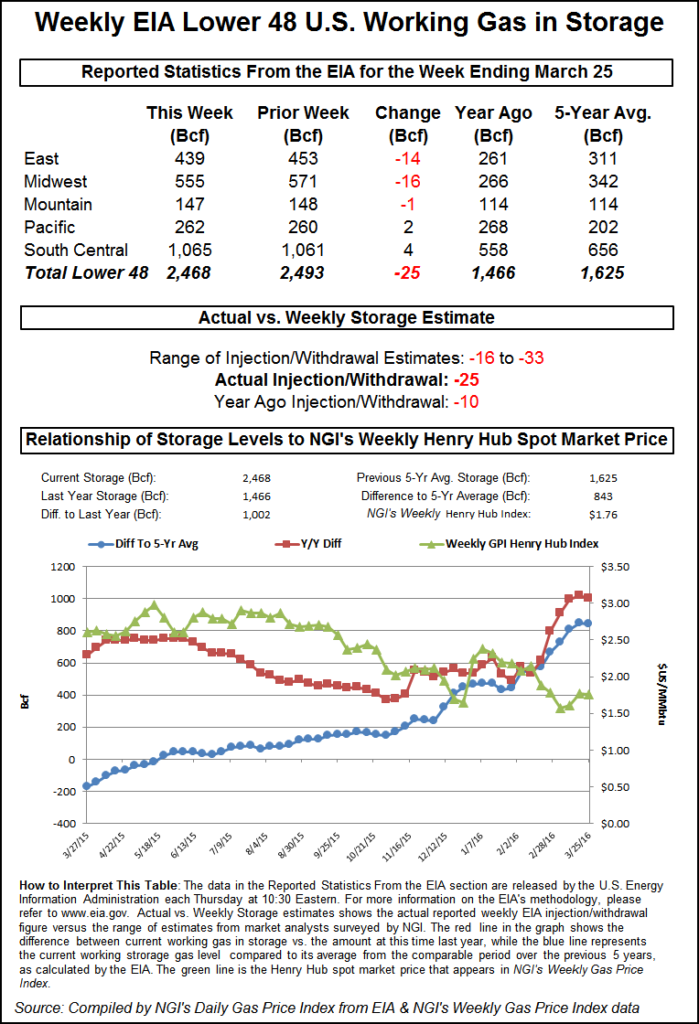Markets | NGI All News Access | NGI Data
NatGas Cash Works Higher, But Futures Disappoint
Physical natural gas traded Thursday for Friday gained about a nickel as robust pricing in the Northeast, Gulf Coast, Midcontinent and Midwest was able to overcome a flat California and soft Rockies pricing environment.

The NGI National Spot Gas Average rose 3 cents to $1.75, and eastern points, on average, gained a dime. The Energy Information Administration (EIA) reported a withdrawal of 25 Bcf from storage for the week ending March 25, and in spite of the fact that most traders were expecting a pull about 3 Bcf lower, prices eased. At the close, May had retreated 3.7 cents to $1.959 and June had given up 5.6 cents to $2.054. May crude oil rose 2 cents to $38.34/bbl.
Spot prices in both New England and Midwest markets rose modestly as demand was forecast to increase going into the weekend. According to industry consultant Genscape Energy, New England (Maine to Connecticut) demand Thursday of 2.52 Bcf/d was expected to drop to 2.12 Bcf/d Friday before rising to 2.45 Bcf/d by Saturday.
In the Midwest (Minnesota and Iowa to Michigan and Indiana) Thursday demand of 10.07 Bcf/d was forecast to ease to 9.62 Bcf/d Friday before rising to 9.86 Bcf/d by Saturday.
Gas at the Algonquin Citygate rose 5 cents to $1.35, and deliveries on Tenn Zone 6 200L added a dime to $1.50. Gas on Iroquois, Waddington was quoted 5 cents higher at $1.98.
Midwest quotes were steady to higher. Gas on Alliance changed hands 6 cents higher at $1.92, and gas priced at the Chicago Citygate added a penny to $1.96. Deliveries to Michigan Consolidated rose 4 cents to $1.94, and parcels on Consumers added 9 cents to $1.96.
Estimates for the Thursday morning EIA storage report were coming in widely dispersed. Storage currently stands at 2,493 Bcf. Last year 10 Bcf was withdrawn, and the five-year pace is for a 22 Bcf decline. Ritterbusch and Associates was calculating a 16 Bcf pull, and a Reuters survey of 24 traders and analysts revealed an average 22 Bcf withdrawal with a range of -16 to -33 Bcf. ICAP Energy figured on a 28 Bcf decline.
Last week’s 15 Bcf build caught a number of analysts off guard; this week’s storage report might do the same. Fifteen Bcf was about 7 Bcf less than what was expected last week. “This week we see as another tricky week,” said John Sodergreen, editor of Energy Metro Desk.
May futures were trading at $2.015 when the EIA data rattled across trading screens and by 10:45 a.m. EDT May was trading at $1.985, down 1.1 cents from Wednesday’s settlement.
“I had heard a 22 Bcf withdrawal, but others were telling me -27 to -28, so the 25 Bcf draw doesn’t come as much of a surprise,” said a New York floor trader. “We are solidly in the $2 range, and I look for trading between $1.90 to $2.10.”
Could supply be getting a little tighter? “The 25 Bcf draw for last week was somewhat more than expected and marginally supportive compared with the 22-Bcf five-year average for the date,” said Tim Evans of Citi Futures Perspective. “It also suggests a somewhat tighter supply-demand balance baseline that may carry over into future periods.”
Inventories now stand at 2,468 Bcf and are a stout 1,002 Bcf greater than last year and 843 Bcf more than the five-year average. In the East Region 14 Bcf was withdrawn and the Midwest Region saw inventories fall by 16 Bcf. Stocks in the Mountain Region fell 1 Bcf, and the Pacific Region was higher by 2 Bcf. The South Central Region added 4 Bcf.
One trader said at the close that the disappointing performance by futures was due to numerous anxious sellers willing to take the best price they could get. “It was really disappointing price action,” a New York floor trader told NGI.
Some analysts are holding fast to lower prices. “[Thursday’s] price action fortified our bearish outlook in this market as the 25 Bcf storage withdrawal was at the high side of expected street ideas and well above our expected 16 Bcf decline,” said Jim Ritterbusch of Ritterbusch and Associates in closing comments.
“The supply surplus against five-year averages was negligibly changed at 843 Bcf. This overhang continues to restrict occasional price advances as was clearly evidenced today. But at the same time, the near-record supply is also well discounted and as a consequence, the huge stockpile is becoming a well-worn reason for anticipating lower values.
“We have adjusted our price parameter for the May contract to the $1.73 level but may be forced to raise it again if production shows further evidence of decline. At the end of the day, this market could easily morph into a low volume narrow range trade across most of next month as the weather factor loses further influence. Next support develops at the Monday lows of $1.84, but a test of this level could easily await another EIA storage report. But for now, we suggest maintaining any short positions established within the $1.95-2.00 zone as we tweak our suggested stop point downward to the $2.03 level on a close only basis.”
© 2024 Natural Gas Intelligence. All rights reserved.
ISSN © 1532-1231 | ISSN © 2577-9877 |
